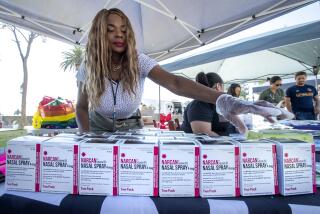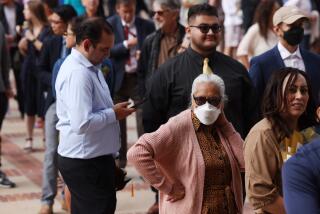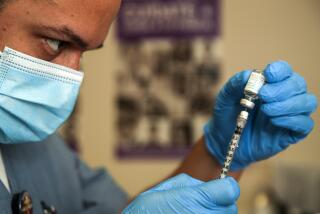Drug Use and AIDS
- Share via
New figures on the relentless spread of AIDS among heterosexual intravenous drug users inLos Angeles County underscore the gravity of this threat to the general population. The figures also dramatize the inadequacy of the response being made.
Los Angeles overtook San Francisco last year to become the second most affected city in the AIDS pandemic, with 1,580 new cases--an average of 132 cases a month. In the first four months of this year 673 cases have been reported in the county--an average of 168 a month. Within those totals the number of cases involving intravenous drug users is relatively small, 11% of the total--8% homosexual or bisexual, 3% heterosexual. However, the number of new cases among heterosexual intravenous drug users is more than doubling every 12 months. There currently are 10 new cases a month in this group, and that will reach an estimated 48 per month in 1990 and 130 a month by 1991.
The heterosexual drug user poses a grave danger to the community because this population, through its sexual activity outside the drug-abuse groups, is the major carrier of AIDS to the general population. Despite the seriousness of the threat, community services are declining rather than expanding. Because of the constraints of Proposition 13 on county funding, and cuts at the federal level, county services are at 80% of the level that existed in 1981. There are at least 80,000 drug abusers in the county, but only about 25,000 are engaged in any kind of rehabilitation program at one time. And for those wanting subsidized rehabilitation there are waits--some perilously long, ranging from a week and a half for an outpatient detoxification program to 21 weeks for admission to a methadone maintenance program. The waits have been cited by the Presidential AIDS Commission as a critical defect in the national effort to control AIDS, with the commission calling for a massive federal funding program to remedy the situation.
Clearly the situation is getting worse.
This was recognized last week in an appeal to the County AIDS Commission from the new UnitedAIDS Coalition of Los Angeles County, bringing together for the first time the 20 principal AIDS service organizations in the county. The leaders of 13 of the organizations have told the commission that “it is critical that we find a way to supply individuals with clean needles--either through needle exchange programs, public education programs regarding proper cleansing methods, and/or the free distribution of needles.”
That recommendation is before the commission’s Intravenous Drug User Task Force. So also is a proposal from the County Department of Health Services for an extensive program with outreach to drug users, including the distribution of educational materials in street vernacular, condoms, and bleach for cleaning needles--but no plans for a needle exchange or needle supply program. The AIDS commission will review a task-force recommendation next month. That could set the stage for a new direction in county policy. The Board of Supervisors earlier this year rejected even a study of the concept of a clean-needle program. But at that time the board had not received any proposal from its own AIDS commission.
Without additional federal funding for treatment, a clean-needle program will have only limited consequences. Irma Stantz, head of the County Drug Abuse Program Office, estimates that $14.5 million a year is required just to catch up with the drug rehabilitation programs of 1981. The Presidential AIDS Commission has estimated an annual cost of $1.5 billion, equally shared by the federal and state governments, over the mext decade, to address the drug-abuse treatment needs essential to contain the abuse problem and its attendant risk of AIDS.
For the moment, time is on the side of Los Angeles County. Tests of those who are in drug-abuse treatment indicate that no more than 5% carry the human immunodeficiency virus that causes AIDS. That contrasts with infection rates of more than 50% in highly affected areas of New York and New Jersey. But the infection rate obviously will not remain low unless major programs are implemented. And there is no cheap way to do that.
More to Read
Sign up for Essential California
The most important California stories and recommendations in your inbox every morning.
You may occasionally receive promotional content from the Los Angeles Times.










